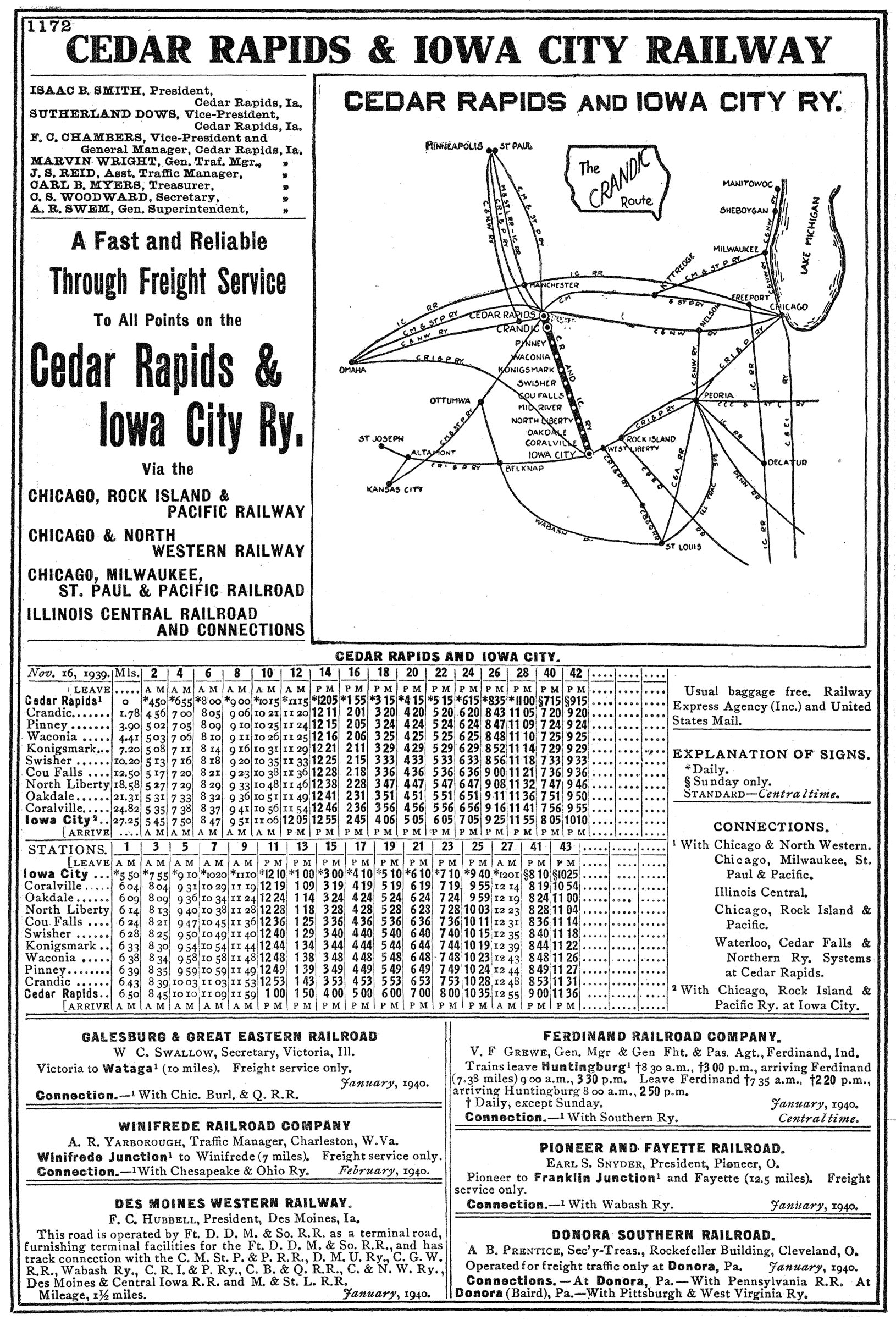Cedar Rapids & Iowa City Railway: "The CRANDIC Route"
Last revised: August 23, 2024
By: Adam Burns
The Cedar Rapids & Iowa City Railway (also known as the "Crandic
Route", following its initials) is one of a very few original interurban
lines that survives, quite successfully, today as a Class III, short line.
When the interurban industry sprung to life around the turn of the 20th century most builders put little stock into potential freight traffic believing that regional and local passenger business would sustain their lines for many years.
Unfortunately, this proved to be a mistake as the industry faltered less than two decades later. However, a few lines like the Crandic were visionaries and spent much effort developing freight traffic.
It proved so well for the little interurban, which connected its namesake cities in eastern Iowa that freight derived nearly all of its traffic even during the early years.
After passenger service ended the road dieselized and today it continues to thrive on a mix of interchange traffic and several customers.
While the Cedar Rapids & Iowa City is a modern short line operation today its heritage can still be seen through its right-of-way.
Like many interurbans the system was built along a highway, in this case Route 965 running south of Cedar Rapids into Iowa City. Also note the modern high-tension lines along the ROW, vestiges of its time as an electrified operation.
Photos
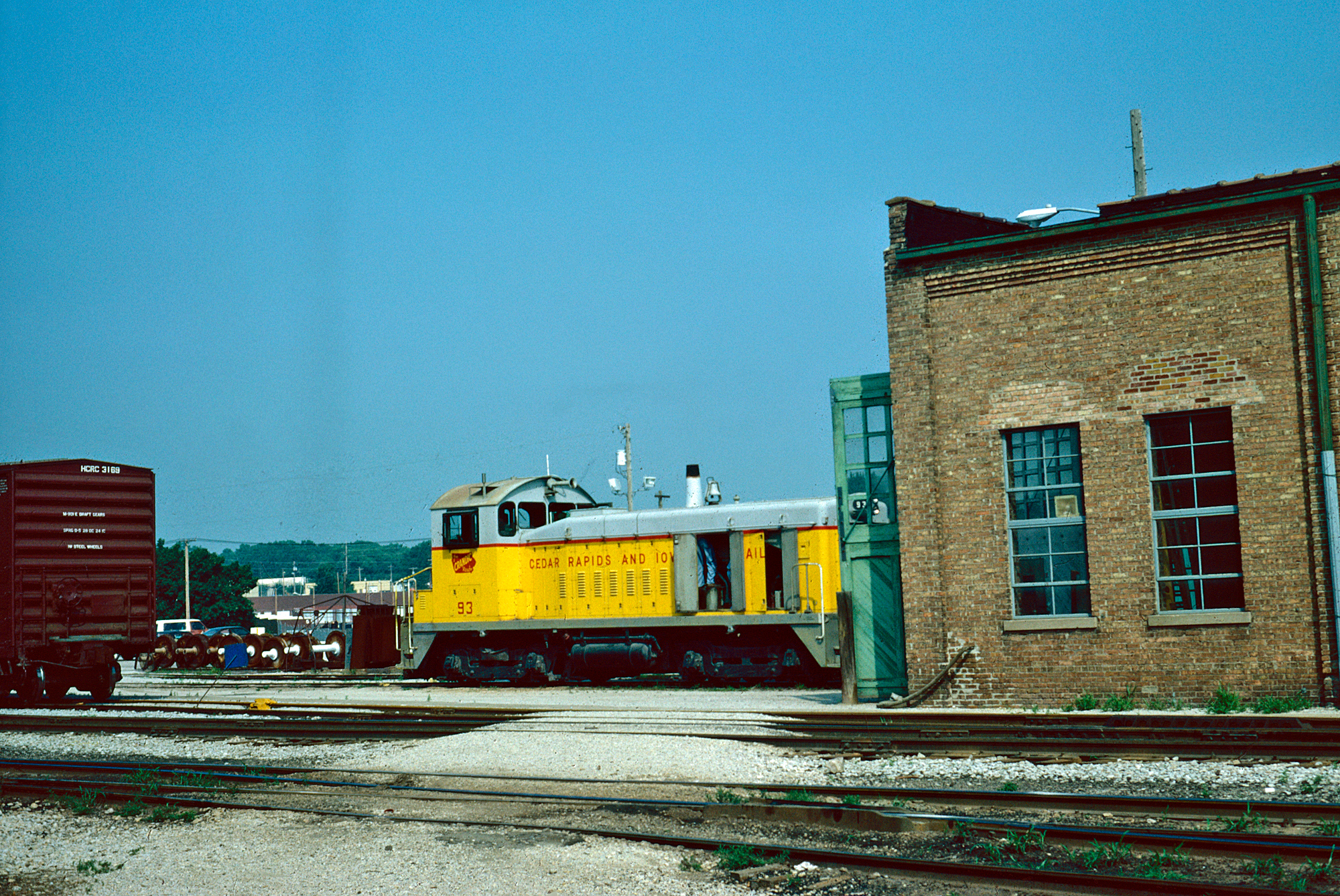 Cedar Rapids & Iowa City Railway SW8 #93 receives attention at the shops in Cedar Rapids, Iowa during June of 1981. American-Rails.com collection.
Cedar Rapids & Iowa City Railway SW8 #93 receives attention at the shops in Cedar Rapids, Iowa during June of 1981. American-Rails.com collection.History
The Cedar Rapids and Iowa City Railway (reporting marks, CIC) first began operations on August 13, 1904 during the major interurban construction boom that occurred during the first decade of the 20th century.
The Crandic was owned by the Iowa Railway & Light Company. At the time it was rather common for power companies to either own or purchase interurbans since they could provide electricity to the right-of-way as well as derive any potential profits from the line.
The Crandic's original main line connected Cedar Rapids with Iowa City to the south, a distance of 27 miles. The fact that the property was privately owned was significant for a few reasons:
- Firstly, they had complete jurisdiction over their route (many interurbans obtained free rights-of-way along roadsides that proved problematic in later years).
- Secondly, this allowed the company to utilize lower grades and easier curvature (using a public roadway meant interurbans were dealt whatever grades and curves the route was constructed to, which normally meant the lay of the land).
Interurban
It was not long before the Crandic built up a successful carload and interchange freight business thanks to its Iowa City interchange with the Rock Island and did the same with the Milwaukee Road and Chicago & North Western at Cedar Rapids (and later the Illinois Central).
Additionally, because Iowa University was located in Iowa City the interurban saw steady commuter traffic for several years.
In 1914 with operations humming along and revenue high the company looked to expand operations to Davenport.
Had it done so the Crandic would have connected with fellow interurban Clinton, Davenport & Muscatine as well as additional connections with the C&NW, Rock Island, and Milwaukee Road. Starting from Cedar Rapids it reached Mt. Vernon and as far as Lisbon about 17 miles away to the east.
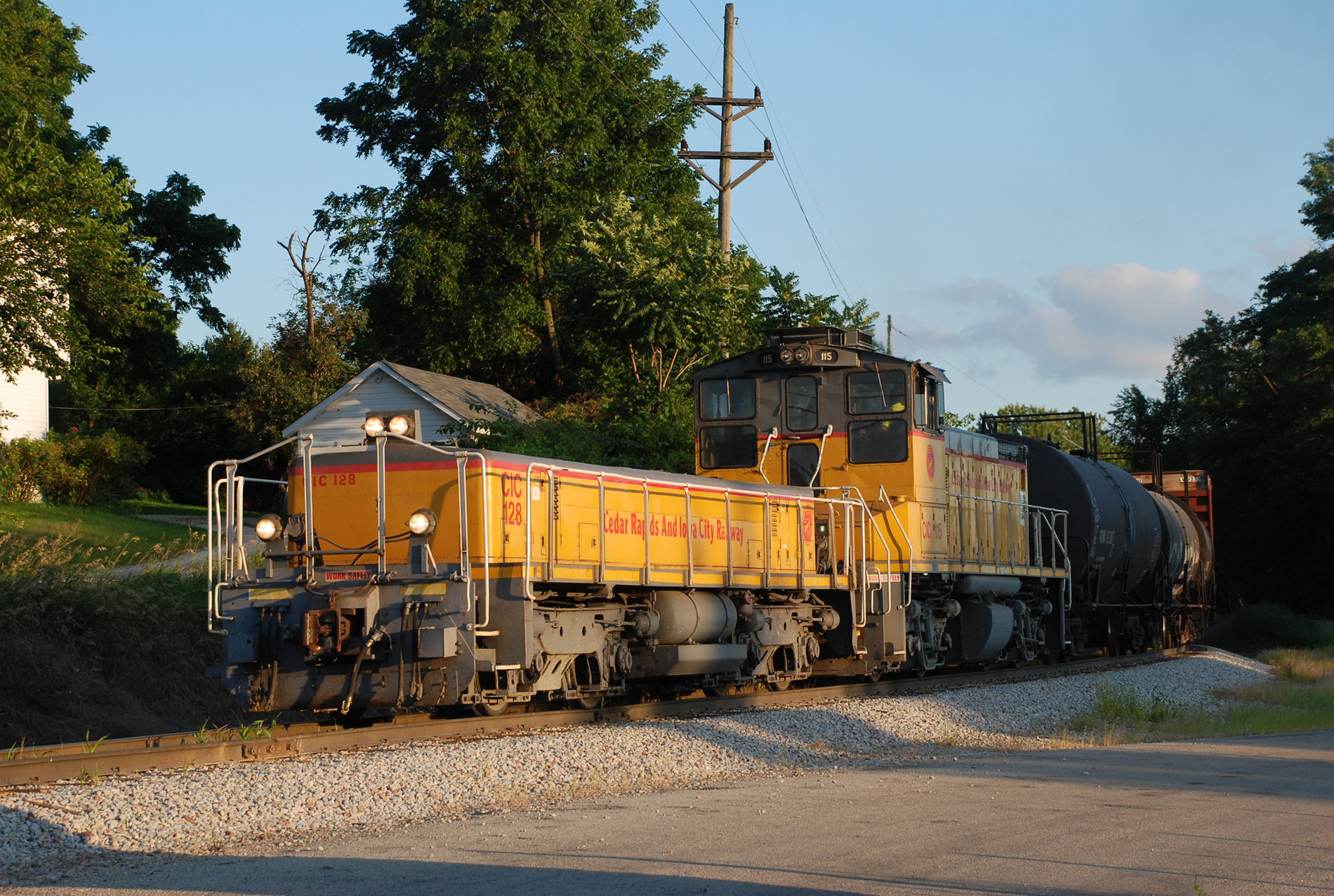 Cedar Rapids & Iowa City MP15DC #115 and slug #128 lead their train into Cedar Rapids on the evening of August 11, 2017. Doug Kroll photo.
Cedar Rapids & Iowa City MP15DC #115 and slug #128 lead their train into Cedar Rapids on the evening of August 11, 2017. Doug Kroll photo.Unfortunately, the plan proved too expensive and with little online traffic from the branch it was scrapped in 1928.
The road, however, continued to prosper and was still seeing decent passenger traffic after World War II and during the very early 1950s allowing it to dispatch up to 14 trains per day.
However, this service began to plummet as early as 1952 and by May 30, 1953 it abandoned passenger operations altogether.
Directly after this the "new" shortline railroad scrapped its overhead catenary for diesel locomotives mostly in the way of early EMD switchers.
With freight volumes during the times allowing the Cedar Rapids and Iowa City Railway to see revenues topping more than $1 million annually it is no surprise the company was quick to end its passenger business once it began to do more harm than good to its overall bottom line.
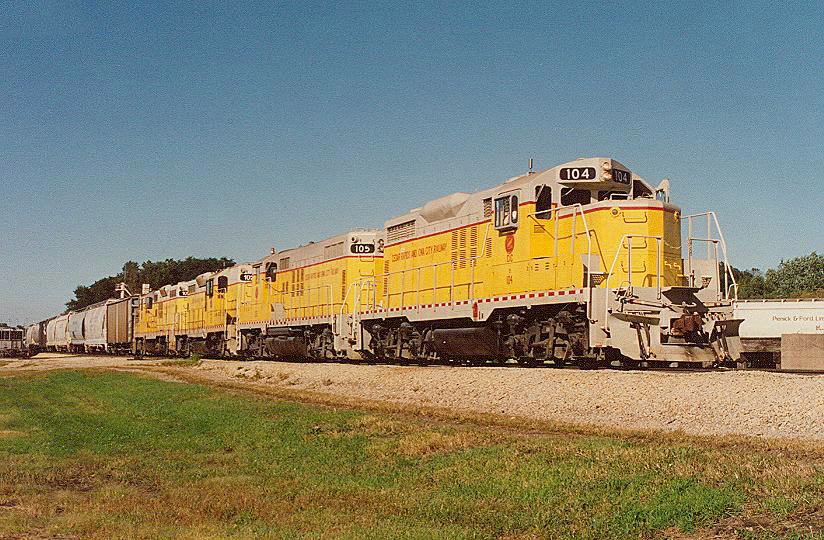 Cedar Rapids & Iowa City GP9 #104 leads a trio of other GP9s with a freight at Cedar Rapids on September 10, 1993. Doug Kroll photo.
Cedar Rapids & Iowa City GP9 #104 leads a trio of other GP9s with a freight at Cedar Rapids on September 10, 1993. Doug Kroll photo.Short Line Operations
From the 1950s through the 1960s and into the 1970s the Crandic continued to function in much the same fashion, providing service to local customers and interchange operations with the Milwaukee, C&NW, IC, and Rock Island.
As the industry hit rock bottom in the 1970s, however, things began to change with both the Rock and Milwaukee in serious financial difficulty.
With the bankruptcy of the CMStP&P the Crandic picked up its line between Cedar Rapids and just south of Amana, a distance of about 20 miles (this line once connected to Ottumwa).
Also, with the Rock being liquidated in 1980 the railroad purchased 15 miles of its branch between Iowa City and Montezuma to Hills.
Today, the company still operates these lines along with its original route; in total owning about 60 miles, which does not include sidings, yards, and spurs.
In place of classic lines like those mentioned above today the Crandic Route interchanges with Union Pacific, Iowa Interstate, Iowa Northern, and Chicago Central & Pacific.
System Map (1940)
The railroad's traffic base is a mixture of interchange traffic along with agriculture, coal, and paper products (this has changed somewhat from its early years when traffic was a mix of coal, milk, lumber, and agriculture).
Interestingly, for a line just 60 miles in length it employs almost 100 with carloads nearly reaching 100,0000 annually.
The line's motive power continues to use a yellow livery from its early years, although today with some equipment coming from Union Pacific it has merely removed the Class I's markings in place of its own (which includes its original logo, "The Crandic Route" with an outline of the state of Iowa).
Locomotive Roster
| Builder | Model Type | Road Number | Built | Quantity |
|---|---|---|---|---|
| EMD | SW8 | 90-93, 96 | 1953 | 5 |
| EMD | SW900 | 94 | 1959 | 1 |
| EMD | SW9 | 95 | 1951 | 1 |
| EMD | SW1200 | 97-99 | 1952, 1966 | 3 |
| EMD | SW14 | 106-109 | 1950 | 2 |
| EMD | GP9 | 104 | 1958 | 1 |
| EMD | GP35M-3 | 110-114 | 1964-1965 | 5 |
| EMD | MP15DC | 115, 121-123, 130-133 | 1974-1976 | 9 |
| EMD | SW1500 | 116-120 | 1970-1971 | 5 |
| EMD | Slug | 124-129 | 1937-1966 | 6 |
| RELCO | L4-1500XD-M | 200-207 | 2013 | 8 |
| RELCO | Slug | 300-307 | 2013 | 8 |
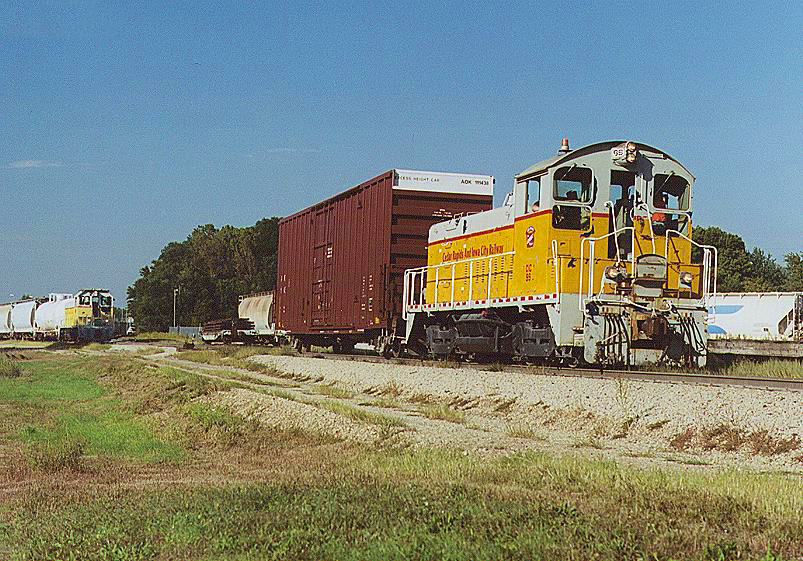 Crandic SW14 #106 does switching work in Cedar Rapids on September 15, 2006. This unit began its career as Illinois Central SW9 #9460 and was rebuilt at the ICG's Paducah shops into its current layout. Doug Kroll photo.
Crandic SW14 #106 does switching work in Cedar Rapids on September 15, 2006. This unit began its career as Illinois Central SW9 #9460 and was rebuilt at the ICG's Paducah shops into its current layout. Doug Kroll photo.Today
While trains on the line may no longer "Swing and Sway the Crandic Way" (a popular song derived from the rocking motion of the fast "Red Devil" interurban cars it purchased from the defunct Cincinnati & Lake Erie in 1939) the railroad looks to remain a strong shortline for years to come.
It enjoys a diverse traffic base and numerous interchange partners; not bad for an interurban that survived that downfall of an industry that collapsed between 1920 and World War II.
Perhaps history on the Crandic will repeat itself. In July of 2015 it was announced a new study would be undertaken looking at the possibility of restoring passenger service between Iowa City and Eastern Iowa Airport in Cedar Rapids to cut down on growing congestion along nearby Interstate 380.
If you would like to learn more about the Cedar Rapids & Iowa City please click here to visit their official website.
Recent Articles
-
Indiana's Dinner Train Rides In Jasper!
Jan 18, 26 01:54 PM
In the rolling hills of southern Indiana, the Spirit of Jasper offers one of those rare attractions that feels equal parts throwback and treat-yourself night out: a classic excursion train paired with… -
New Mexico's Dinner Train Rides
Jan 18, 26 01:37 PM
If your heart is set on clinking glasses while the desert glows at sunset, you can absolutely do that here—just know which operator offers what, and plan accordingly. -
New Hampshire ~ Murder Mystery ~ Dinner Train Rides
Jan 18, 26 01:10 PM
The state's murder mystery trains stand out as a captivating blend of theatrical drama, exquisite dining, and scenic rail travel. -
New York Valentine's Train Rides
Jan 18, 26 12:32 PM
At its best, the Adirondack Railroad delivers exactly what railfans and casual riders alike hope for: vintage coaches, classic depots, rivers and forests right outside the window. -
Washington Valentine's Train Rides
Jan 18, 26 10:50 AM
Whether you’re a dedicated railfan chasing preserved equipment or a couple looking for a memorable night out, CCR&M offers a “small railroad, big experience” vibe—one that shines brightest on its spec… -
Colorado Valentine's Train Rides
Jan 18, 26 10:49 AM
The Royal Gorge Route Railroad is the kind of trip that feels tailor-made for railfans and casual travelers alike, including during Valentine's weekend. -
Georgia Valentine's Train Rides
Jan 18, 26 10:42 AM
f you’ve ridden the SAM Shortline, it’s easy to think of it purely as a modern-day pleasure train—vintage cars, wide South Georgia skies, and a relaxed pace that feels worlds away from interstates and… -
New Jersey ~ Murder Mystery ~ Dinner Train Rides
Jan 17, 26 01:16 PM
There are currently no murder mystery dinner trains available in New Jersey although until 2023 the Cape May Seashore Lines offered this event. Perhaps they will again soon! -
West Virginia Dinner Train Rides In Elkins!
Jan 17, 26 01:08 PM
The D&GV offers the kind of rail experience that feels purpose-built for railfans and casual travelers. -
Virginia Dinner Train Rides In Staunton!
Jan 17, 26 11:55 AM
If you’ve ever wished you could pair a classic scenic train ride with a genuinely satisfying meal—served at your table while the countryside rolls by—the Virginia Scenic Railway was built for you. -
Florida Easter Train Rides
Jan 17, 26 10:23 AM
The cold weather rarely invades Florida and the state nearly always warm and balmy early spring temperatures. Learn more about where you can find Easter-themed train rides across the Sunshine State. -
Ohio Easter Train Rides
Jan 17, 26 10:13 AM
Ohio is home to several museums and excursion trains preserving the state's rich railroading heritage. A few of these locations host Easter-themed train rides each spring. -
Massachusetts Valentine's Train Rides
Jan 17, 26 09:58 AM
The Cape Cod Central Railroad (CCCR) blends classic New England scenery with heritage equipment, narrated sightseeing, and some of the region’s best-known “rails-and-meals” experiences. -
California Valentine's Train Rides
Jan 17, 26 09:53 AM
Operating out of West Sacramento, this excursion railroad has built a calendar that blends scenery with experiences—wine pours, themed parties, dinner-and-entertainment outings, and seasonal specials… -
South Carolina Dinner Train Rides
Jan 16, 26 11:13 PM
There is only location in the Palmetto State offering a true dinner train experience can be found at the South Carolina Railroad Museum. Learn more here. -
Rhode Island Dinner Train Rides
Jan 16, 26 11:01 PM
Despite its small size, Rhode Island is home to one popular dinner train experience where guests can enjoy the breathtaking views of Aquidneck Island. -
Pennsylvania's Thomas The Train Rides
Jan 16, 26 04:13 PM
"A Day Out With Thomas” train rides offer a unique opportunity for children and their families to engage in a magical and memorable experience, setting the stage for a full day of fun and adventure. -
Illinois's Thomas The Train Rides
Jan 16, 26 02:23 PM
In Illinois, the "A Day Out With Thomas" event offers a unique chance for families to immerse themselves in the enchanting world of Thomas and friends, creating memories that last a lifetime. -
New Jersey's Thomas The Train Rides
Jan 16, 26 02:11 PM
Here's a comprehensive guide to what you can expect at Day Out With Thomas events in New Jersey. -
Texas ~ Murder Mystery ~ Dinner Train Rides
Jan 16, 26 01:54 PM
Here’s a comprehensive look into the world of murder mystery dinner trains in Texas. -
Connecticut ~ Murder Mystery ~ Dinner Train Rides
Jan 16, 26 01:26 PM
All aboard the intrigue express! One location in Connecticut typically offers a unique and thrilling experience for both locals and visitors alike, murder mystery trains. -
New Hampshire Dinner Train Rides In N. Conway!
Jan 16, 26 10:47 AM
Tucked into the heart of New Hampshire’s Mount Washington Valley, the Conway Scenic Railroad is one of New England’s most beloved heritage railways -
Oregon Dinner Train Rides Near Mt. Hood!
Jan 16, 26 10:44 AM
The Mt. Hood Railroad is the moving part of that postcard—a century-old short line that began as a working railroad. -
Maryland's - Wine Tasting - Train Rides
Jan 15, 26 02:59 PM
This article delves into the enchanting world of wine tasting train experiences in Maryland, providing a detailed exploration of their offerings, history, and allure. -
Colorado's - Wine Tasting - Train Rides
Jan 15, 26 02:46 PM
To truly savor these local flavors while soaking in the scenic beauty of Colorado, the concept of wine tasting trains has emerged, offering both locals and tourists a luxurious and immersive indulgenc… -
Iowa ~ Wine Tasting ~ Train Rides
Jan 15, 26 02:36 PM
The state not only boasts a burgeoning wine industry but also offers unique experiences such as wine by rail aboard the Boone & Scenic Valley Railroad. -
Georgia's Wine Train Rides In Cordele!
Jan 15, 26 02:26 PM
While the railroad offers a range of themed trips throughout the year, one of its most crowd-pleasing special events is the Wine & Cheese Train—a short, scenic round trip designed to feel like a t… -
Indiana ~ Murder Mystery ~ Dinner Train Rides
Jan 15, 26 02:22 PM
This piece explores the allure of murder mystery trains and why they are becoming a must-try experience for enthusiasts and casual travelers alike. -
Ohio ~ Murder Mystery ~ Dinner Train Rides
Jan 15, 26 02:10 PM
The murder mystery dinner train rides in Ohio provide an immersive experience that combines fine dining, an engaging narrative, and the beauty of Ohio's landscapes. -
Nevada Dinner Train Rides In Ely!
Jan 15, 26 02:01 PM
If you’ve ever wished you could step through a time portal into the hard-working world of a 1900s short line the Nevada Northern Railway in Ely is about as close as it gets. -
Michigan Dinner Train Rides In Owosso!
Jan 15, 26 09:46 AM
The Steam Railroading Institute is best known as the home of Pere Marquette #1225 and even occasionally hosts a dinner train! -
Arizona's - Wine Tasting - Train Rides
Jan 14, 26 02:04 PM
For those who want to experience the charm of Arizona's wine scene while embracing the romance of rail travel, wine tasting train rides offer a memorable journey through the state's picturesque landsc… -
Arkansas's - Wine Tasting - Train Rides
Jan 14, 26 01:57 PM
This article takes you through the experience of wine tasting train rides in Arkansas, highlighting their offerings, routes, and the delightful blend of history, scenery, and flavor that makes them so… -
Tennessee ~ Murder Mystery ~ Dinner Train Rides
Jan 14, 26 01:42 PM
Amidst the rolling hills and scenic landscapes of Tennessee, an exhilarating and interactive experience awaits those with a taste for mystery and intrigue. -
California ~ Murder Mystery ~ Dinner Train Rides
Jan 14, 26 01:26 PM
When it comes to experiencing the allure of crime-solving sprinkled with delicious dining, California's murder mystery dinner train rides have carved a niche for themselves among both locals and touri… -
Illinois ~ Murder Mystery ~ Dinner Train Rides
Jan 14, 26 01:13 PM
Among Illinois's scenic train rides, one of the most unique and captivating experiences is the murder mystery excursion. -
Vermont's - Murder Mystery - Dinner Train Rides
Jan 14, 26 12:57 PM
There are currently murder mystery dinner trains offered in Vermont but until recently the Champlain Valley Dinner Train offered such a trip! -
Massachusetts Dinner Train Rides On Cape Cod!
Jan 14, 26 12:20 PM
The Cape Cod Central Railroad (CCCR) has carved out a special niche by pairing classic New England scenery with old-school hospitality, including some of the best-known dining train experiences in the… -
Maine Dinner Train Rides In Portland!
Jan 14, 26 11:31 AM
While this isn’t generally a “dinner train” railroad in the traditional sense—no multi-course meal served en route—Maine Narrow Gauge does offer several popular ride experiences where food and drink a… -
Kentucky Dinner Train Rides In Bardstown!
Jan 13, 26 01:14 PM
The essence of My Old Kentucky Dinner Train is part restaurant, part scenic excursion, and part living piece of Kentucky rail history. -
Kansas Dinner Train Rides In Abilene!
Jan 13, 26 12:44 PM
If you’re looking for a heritage railroad that feels authentically Kansas—equal parts prairie scenery, small-town history, and hands-on railroading—the Abilene & Smoky Valley Railroad (A&SV) delivers. -
Michigan ~ Murder Mystery ~ Dinner Train Rides
Jan 13, 26 11:24 AM
Among the lesser-known treasures of this state are the intriguing murder mystery dinner train rides—a perfect blend of suspense, dining, and scenic exploration. -
Virginia's - Murder Mystery - Dinner Train Rides
Jan 13, 26 11:11 AM
Among the state's railroad attractions, murder mystery dinner trains stand out as a captivating fusion of theatrical entertainment, fine dining, and scenic travel. -
Arizona Dinner Train Rides At The Grand Canyon!
Jan 13, 26 10:59 AM
While the Grand Canyon Railway does not offer a true, onboard dinner train experience it does offer several upscale options and off-train dining. -
Georgia Dinner Train Rides In Nashville!
Jan 13, 26 10:27 AM
If you’ve ever wished you could slow down, trade traffic for jointed rail, and let a small-town landscape roll by your window while a hot meal is served at your table, the Azalea Sprinter delivers tha… -
Indiana Valentine's Train Rides
Jan 12, 26 04:27 PM
If you’ve ever wished you could step into a time when passenger trains were a Saturday-night treat and a whistle echoing across farm fields meant “adventure,” the Nickel Plate Express delivers that fe… -
Ohio Valentine's Train Rides!
Jan 12, 26 04:20 PM
The Hocking Valley Scenic Railway offers one of the region’s most atmospheric ways to experience the Hocking Hills area: from the rhythmic click of jointed rail to the glow of vintage coaches rolling… -
Wisconsin's - Wine Tasting - Train Rides
Jan 12, 26 03:10 PM
Wisconsin might not be the first state that comes to mind when one thinks of wine, but this scenic region is increasingly gaining recognition for its unique offerings in viticulture. -
California's - Wine Tasting - Train Rides
Jan 12, 26 02:34 PM
This article explores the charm, routes, and offerings of these unique wine tasting trains that traverse California’s picturesque landscapes. -
Wisconsin Scenic Train Rides In North Freedom!
Jan 12, 26 02:20 PM
The Mid-Continent Railway Museum is a living-history museum built around the sights, sounds, and everyday rhythms of small-town and shortline railroading in the early 20th century, what the museum cal…

